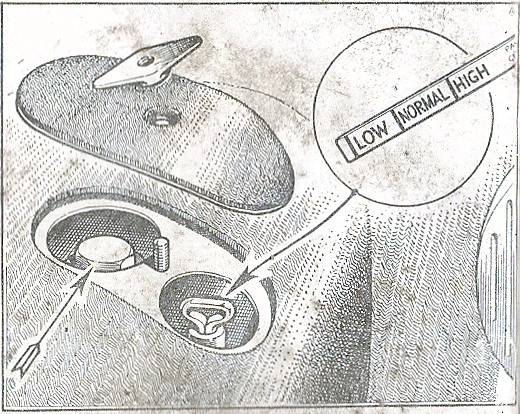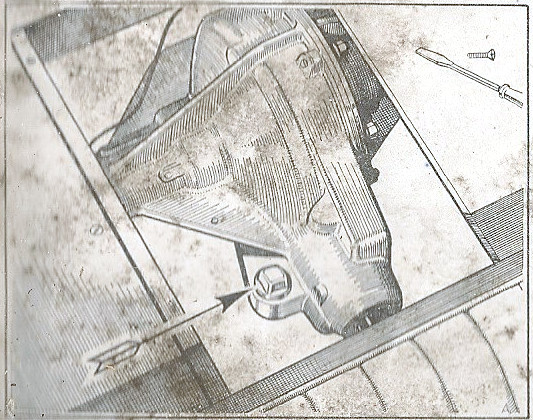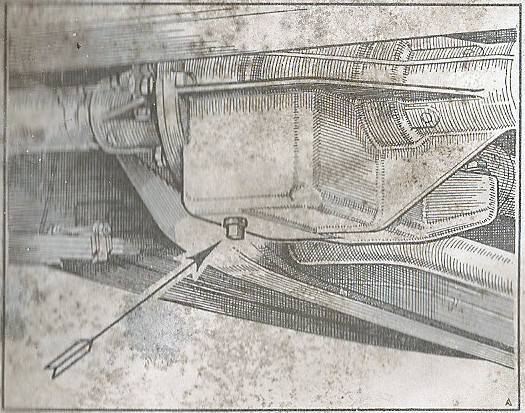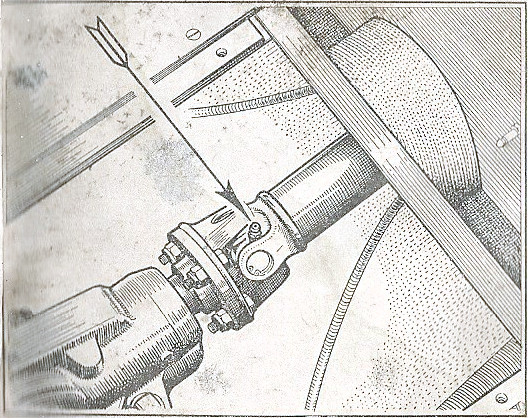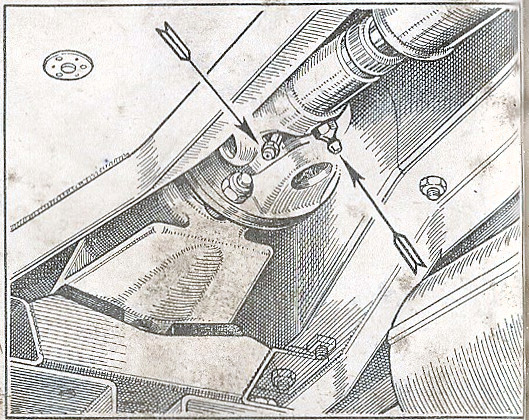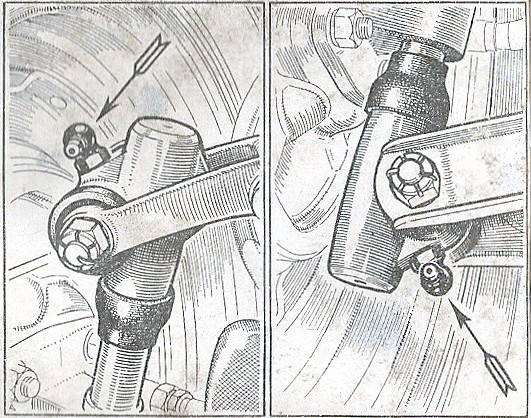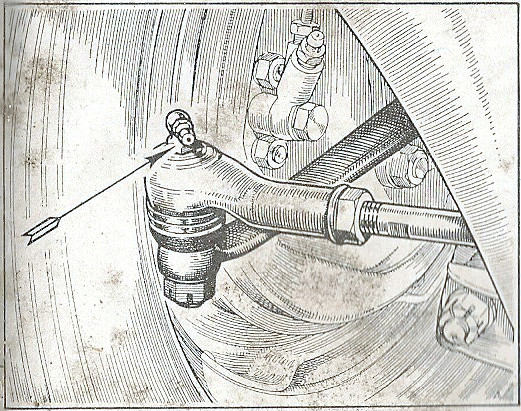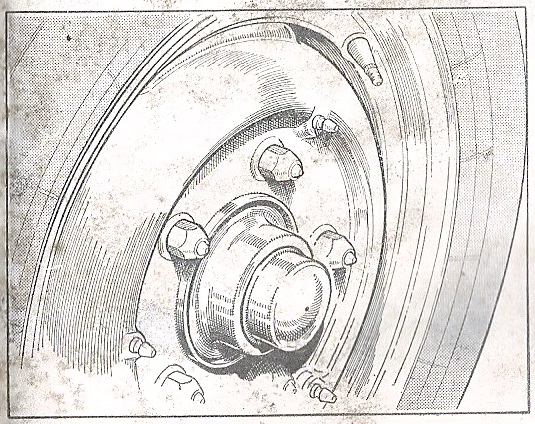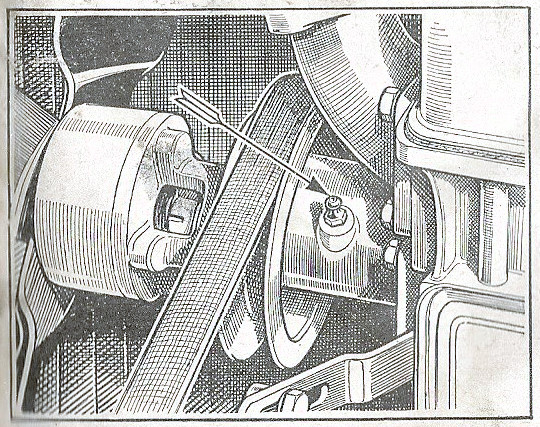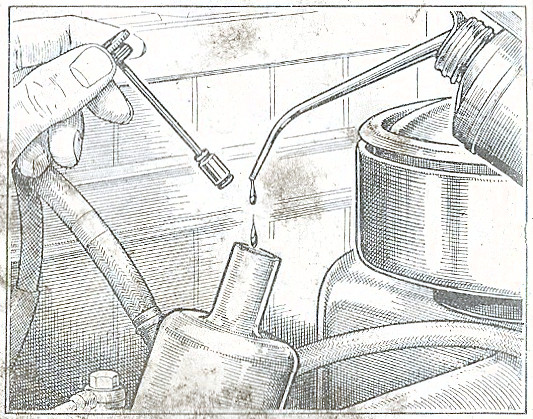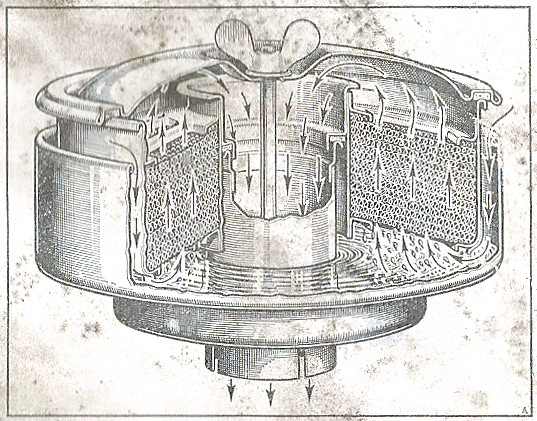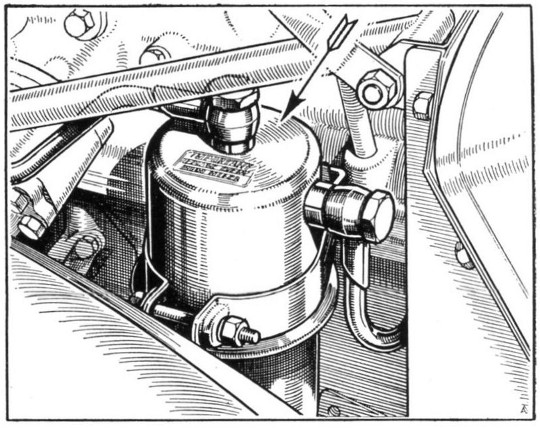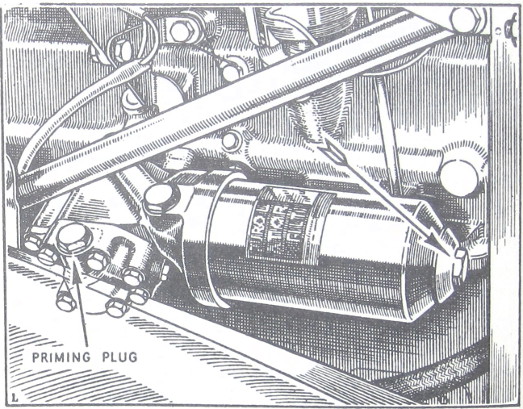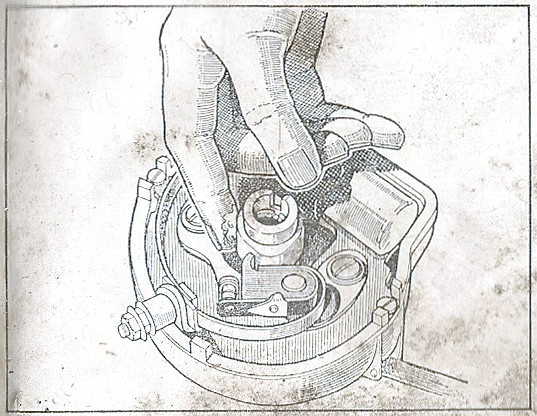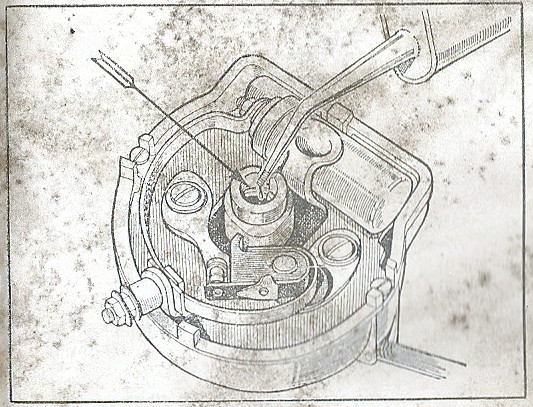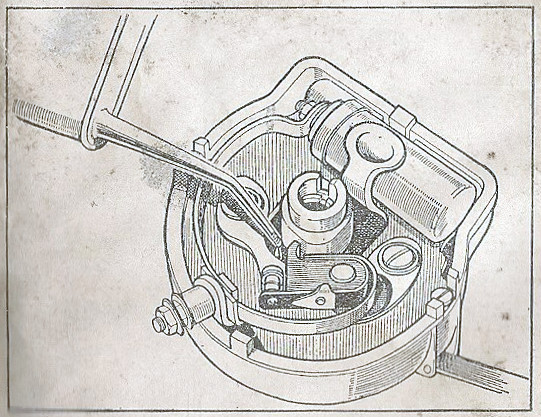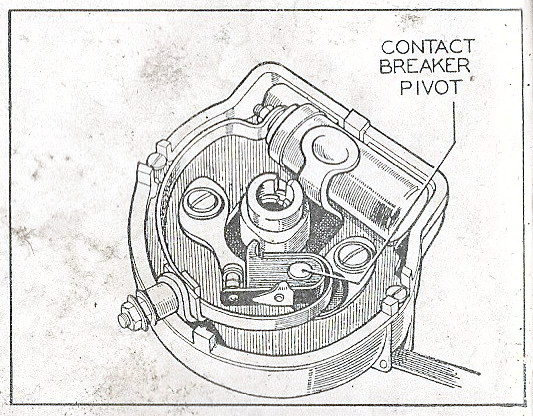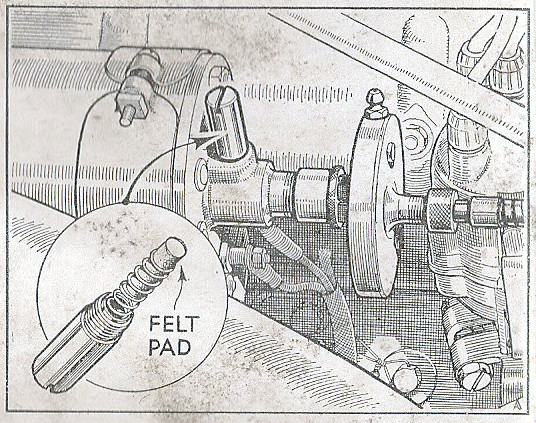RECOMMENDED LUBRICANTS
| A | B | C | D | E | F | ||||
| Component | Engine and Air Cleaner | Gearbox, Steering Gearbox and Rear Axle (Hypoid Gears) | Wheel Hubs and Fan Bearings | Chassis Greasing, Nipples etc. | Cables and Control Joints | Oilcan and Carburetter | |||
| Climatic Conditions | Tropical and temperate down to 32° F. (0° C.) | Cold and extreme cold down to 0° F. (-18° C.) | Arctic below 0° F. (-18° C.) | Tropical and temperate down to 10° F. (-12° C.) | Extreme cold below 10° F. (-12° C.) | All conditions | All conditions | All conditions | All conditions |
| "ENERGOL" (Price's Lubricants Ltd.) | "Energol" Motor Oil S.A.E. 30 | "Energol" Motor Oil S.A.E. 20 | "Energol" Motor Oil S.A.E. 10 | "Energol" Transmission "E.P." S.A.E. 90 |
"Energol" Transmission "E.P." S.A.E. 80 | "Energrease" C.3 | "Energrease" C.1 | "Energrease" C.1 | "Energol" Motor Oil S.A.E. 20 |
| "SHELL" (Shell Mex & B.P. Ltd.) | "Shell" X—I00 S.A.E. 30 | "Shell" X—I00 S.A.E. 20 | "Shell" X—I00 S.A.E. 10 | "Shell" Spirax 90 E.P. | "Shell" Spirax 80 E.P. | "Shell" Retinax H for Hubs Retinax C for Fan |
"Shell" Retinax C | "Shell" Retinax C | "Shell" X—I00 S.A.E. 20 |
| "FILTRATE" (Edward Joy & Sons Ltd.) | Medium "Filtrate" | Zero "Filtrate" | Sub-Zero "Filtrate" | Hypoid "Filtrate" 90 | Hypoid "Filtrate" 80 | "Filtrate" R.B. Grease | H.P. Solidified "Filtrate" | "Filtrate" A.F. Grease | Zero "Filtrate" |
| "STERNOL" (Sternol Ltd.) | "Sternol" W.W. 30 | "Sternol" W.W. 20 | "Sternol" W.W. 10 | "Sternol" Ambroleum E.P. 90 | "Sternol" Ambroleum E.P. 80 | "Ambroline" R.B. Grease | "Ambroline" M.M. Grease | "Ambroline" A.F. Grease | "Sternol" W.W. 20 |
| "DUCKHAM'S" (Alexander Duckham & Co. Ltd.) | Duckham's N.O.L. "Thirty" | Duckham's N.O.L. "Twenty" | Duckham's N.O.L. "Ten" | Duckham's Hypoid 90 | Duckham'S Hypoid 80 | Duckham's H.B.B. Grease | Duckham's H.P.G. Grease | Duckham's "Keenol" K.G.I6 Grease | Duckham's N.O.L. "Twenty" |
| "CASTROL" (C. C. Wakefield & Co. Ltd.) | "Castrol" X.L. | "Castrolite" | "Castrol" Z | "Castrol" Hypoy | "Castrol" Hypoy 80 | "Castrolease" Heavy | "Castrolease" Medium | "Castrolease" Brake Cable Grease | "Castrolite" |
| "ESSOLUBE" (Esso Petroleum Co. Ltd.) | "Essolube" 30 | "Essolube" 20 | "Essolube" 10 | "Esso" Expee Compound 90 | "Esso" Expee Compound 80 | "Esso" Bearing Grease | "Esso" Chassis Lubricant | "Esso" Chassis Lubricant | "Essolube" 20 |
| "MOBILOIL" (Vacuum Oil Co, Ltd.) | Mobiloil "A" | Mobiloil "Artic" | Mobiloil "Artic Special" | Mobilube "G.X." 90 | Mobilube "G.X." 80 | Mobilgrease No. 5 | Mobilgrease No. 2 or 4 | Mobilgrease No. 2 or 4 | Mobiloil "Artic" |
36
LUBRICATION (Engine)
Oil Pressures • Engine Drain Plug
Replenishing Engine Sump
Engine lubrication
The oil supply is carried in the sump below the cylinder block and is drawn through a gauze
internal filter and renewable external filter before circulation through the engine. It will be found on first
starting the engine from cold that a high-pressure reading will be obtained on the oil gauge. This will
gradually drop as the engine warms up and the oil becomes more fluid, until a normal pressure of approximately
25 to 40 lb./sq. in., (1.75 to 2.8 kg./cm.2) is indicated. Avoid racing the engine when first starting up
while the oil is cold. On the other hand, do not let it idle too slowly. It should be allowed to rotate at
approximately 1,000 r.p.m., an engine speed equivalent to 15 m.p.h. (24 k.p.h.) in top gear.
Instructions for checking the quantity of oil in the sump and replenishment are given on
page 6.
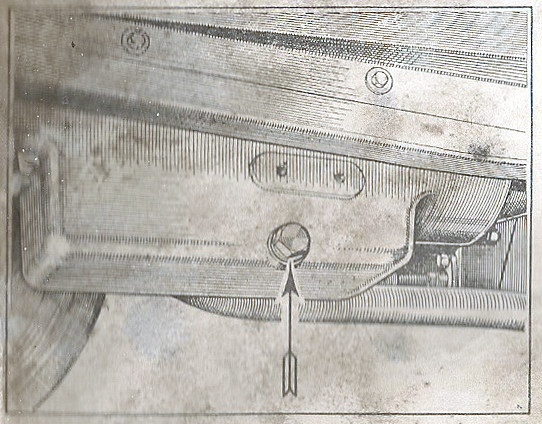
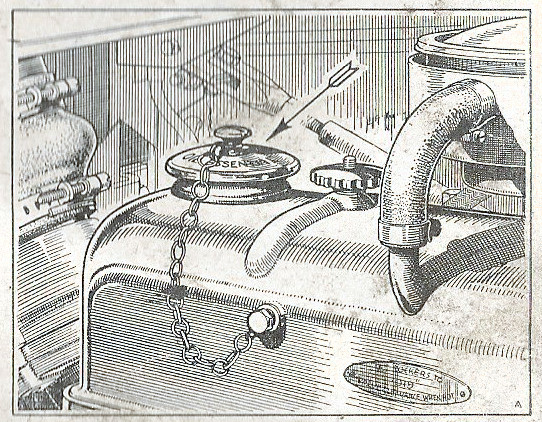
Draining the sump (A)
We recommend that when the car has completed the first 500 miles (800 km.) the oil in the sump
should be drained to clear the sump from any impurities that may have accumulated during the initial
running-in period. After the first 500 miles (800 km.) we recommend that the sump should be drained
every 3,000 miles (5000 km.) and refilled with the recommended lubricant. This operation is best
carried out immediately the car returns from a journey, while the oil is still warm and fluid.
On the left side of the engine will be found a brass drain plug. Removal of this plug will release the
contents of the sump. After carefully cleaning the drain plug, which will probably have an accumulation
of dirt in its hollow centre, it should be replaced and screwed up tightly. When the sump has been
drained completely, approximately 1⅛ gallons (5.1 litres) are required to fill it.
37
